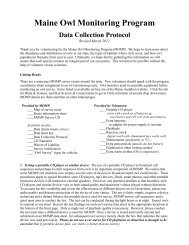Focus Species Forestry - Maine Audubon
Focus Species Forestry - Maine Audubon
Focus Species Forestry - Maine Audubon
You also want an ePaper? Increase the reach of your titles
YUMPU automatically turns print PDFs into web optimized ePapers that Google loves.
Pileated Woodpecker<br />
Distribution: British Columbia to Nova Scotia, south to Florida, east Texas,<br />
and northern California<br />
<strong>Maine</strong> <strong>Focus</strong> Region: Statewide<br />
Home Range: 100-200 acres<br />
Food: Insects in decaying wood, particularly carpenter ant colonies in<br />
decaying trees<br />
Special Habitat Needs: Large (>20 in. diameter) cavity trees for nesting; dead<br />
or decaying deciduous trees or conifers for feeding<br />
Management<br />
Maintain mature forest stands.<br />
Maintain an abundance of large snags and live trees with decaying<br />
wood in managed stands (see Section 7).<br />
Comments: Pileated woodpeckers frequently excavate large rectangular feeding cavities (2-3 in. wide by 4-6 in.<br />
high) in live trees, often low on the bole where ants are present in decayed wood. This large, crow-sized<br />
woodpecker with black body, white underwings, and loud “kuk kuk kuk kuk” call is readily identified by sight,<br />
sound, or sign of feeding activities. Because the pileated, like most other woodpeckers, usually excavates a new<br />
nest cavity every year, an abundance of potential cavity trees is important. Bats, marten, fisher, barred owls, flying<br />
squirrels, raccoons, and other animals will benefit from cavities excavated by pileated woodpeckers. Wood ducks,<br />
goldeneyes, hooded mergansers, and common mergansers nest in large cavities excavated by pileated woodpeckers<br />
near streams and ponds.<br />
Habitat Use:<br />
Aspen-Birch<br />
Forest Ecosystems<br />
Northern<br />
Hardwoods Oak-Pine Hemlock Spruce-Fir<br />
N. White<br />
Cedar<br />
R S I M R S I M L R S I M L I M L R S I M L I M L<br />
C C C C C C C C C C C C C C C C C<br />
Special-value<br />
Habitats<br />
Riparian/<br />
Wetland Vernal<br />
Forest Pool<br />
R Regeneration and seedlings Mx Mixed conifer-deciduous <strong>Focus</strong> habitat<br />
S Saplings and small poles U Understory present Other habitat<br />
I Intermediate-aged forest C Cavity trees, snags, or decaying trees Little/no use<br />
M Mature forest<br />
L Late-successional forest<br />
References: Boone and Krohn 1998, DeGraaf and Yamasaki 2001, Sibley 2000, Terres 1991<br />
46<br />
<strong>Focus</strong> <strong>Species</strong> <strong>Forestry</strong>



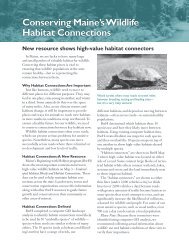
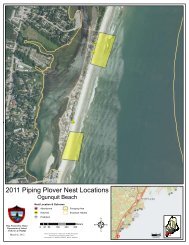
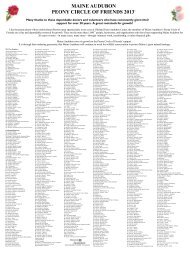
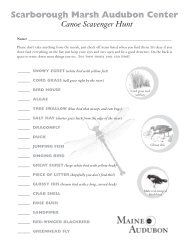

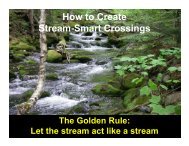
![2012 Loon Count Results [pdf] - Maine Audubon](https://img.yumpu.com/26228732/1/190x245/2012-loon-count-results-pdf-maine-audubon.jpg?quality=85)
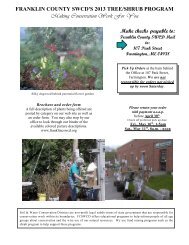
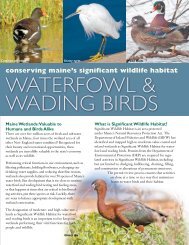
![Lake Fish of Maine (DIFW list) [pdf] - Maine Audubon](https://img.yumpu.com/23282964/1/190x245/lake-fish-of-maine-difw-list-pdf-maine-audubon.jpg?quality=85)
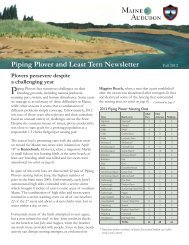

![The Maine Audubon Peony Circle of Friends 2012 [pdf]](https://img.yumpu.com/22707677/1/190x253/the-maine-audubon-peony-circle-of-friends-2012-pdf.jpg?quality=85)
